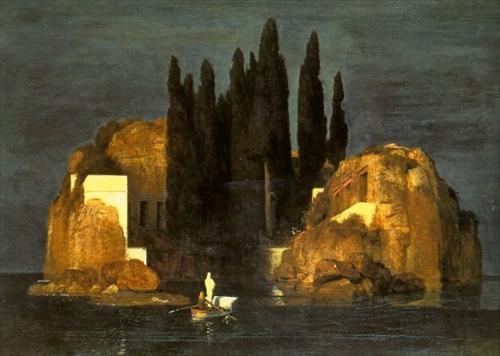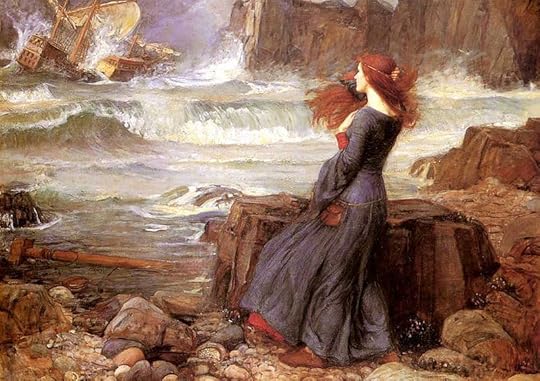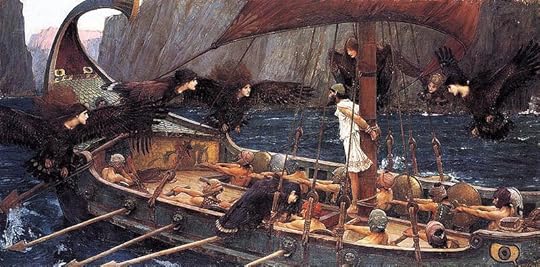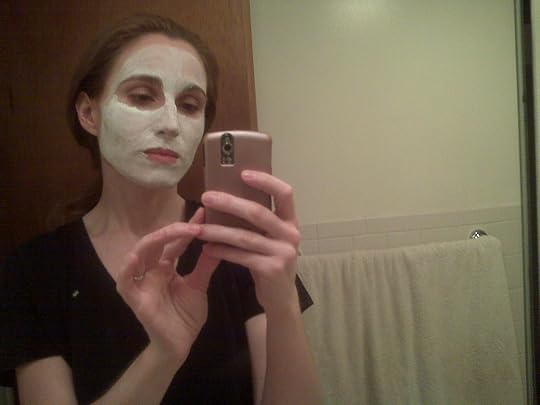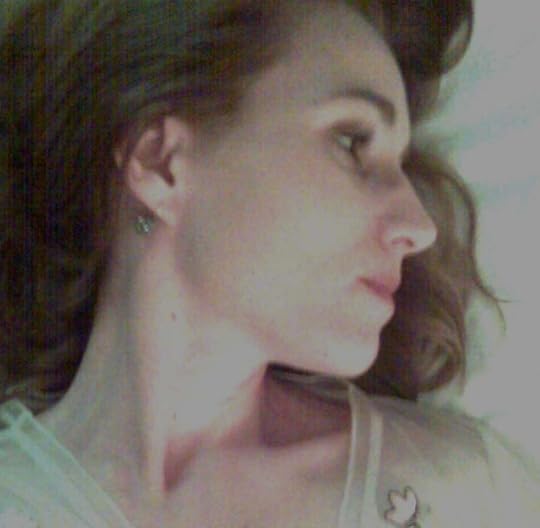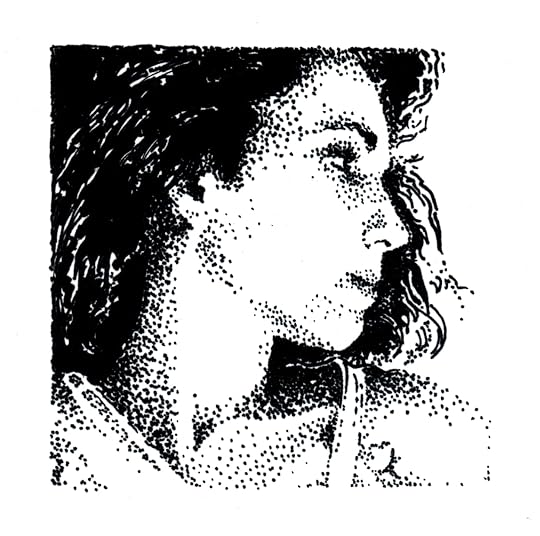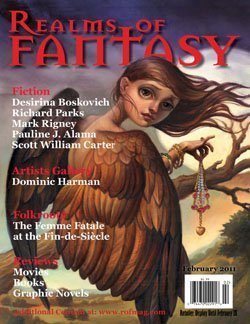Theodora Goss's Blog, page 70
January 24, 2011
Surreal Writing Exercise
Writing Exercise: Choose an image by a surrealist painter and write a story about it.
I chose two images.
The Sacred Wood by Arnold Böcklin:
In the grove by the temple, we knelt before the living flame. It spoke to us, of course, and told us what we had to do.
We were so out of time, out of our own time I mean. Me and Emma and Matilda. What was it, something something B.C.? In a civilization that history had forgotten. The priestesses stood behind us, waiting. They were used to this, they always talked to fire. And water, and tree, and stone. It was we, in our own age, who had forgotten how. Or perhaps our fires and waters and trees and stones had forgotten how to speak.
It's funny, if you think about it. Stuck in something something B.C. among the Ilurians, kneeling before a living flame who tells you to "Find the gray woman, the spinner of webs, the sayer of spells."
"That's Miss Gray," said Matilda.
"Do you think she's here?" asked Emma.
"She's everywhere," I said. "If there's a moment in history when she doesn't exist, it's way before this one."
It told us to look on the mountaintop, hissing as flames do. Well, that was where we would look, then.
And assuming we found Miss Gray, what then? Would she know how we were going to find Sitgreaves? Because you see, and I haven't told you this – somehow or other Sitgreaves had taken Mouse. And Miss Gray, our own Miss Gray, had said, "He's taken her somewhere in time, girls. You'll have to go back or forward, following his trail."
"How can we go forward in time?" Emma had asked. And Miss Gray had frowned, because she had explained about traveling in time the week before in Elementary Time Travel, and she never explained anything twice.
She had sent us back, the way she did everything: shifting space and time with the help of metaphor. Meaning, in this case, an hourglass. "You understand, of course, that the hourglass does nothing," she told us, always the teacher. "It's the mind that shifts time. The metaphor merely gives it something to focus on."
And there we were, greeting the Ilurians and explaining to them that we were from Miss Lavender's School, and had they seen a girl with white hair?
The high priestess told us that, although she had not seen Mouse, any friend of Mrs. Moth's was a friend of hers, although she called Mrs. Moth by another name. And she invited us to meet the oracle. The living flame.
And now, that living flame was telling us to find Miss Gray, the gray woman.
"All right," said Matilda. "On to the mountain. I'm glad we at least got lunch."
The Isle of the Dead by Arnold Böcklin:
He had died again. He had died nine times, at least I think the number was nine. Honesty, I had lost count.
Emma and I rowed him to the Isle of the Dead. Well, I did most of the rowing. Emma stood up in the boat, looking all dramatic and solemn.
"He's going to come back again," I told her. "He always does. He just appears from another point in history."
"I know," she said. "But isn't it romantic? I've never been to a funeral before."
There we were, in something something B.C., and she wanted to stand in a boat and look romantic. Whatever.
I thought about the events of the last few weeks. Finding Miss Gray, or the gray woman as she was known by the Ilurians and random talking flames. She had looked almost exactly like she did in our own time, except that she had been wearing a linen tunic and her hair had been coiled and draped in a series of braids. The first thing she said was, "Emma, stand up straight. Matilda, you have a stain on your school uniform. And Thea, what in the world are you girls doing here anyway?"
We had told her about Sitgreaves taking Mouse. And she had told us where to find them. When we got there, Sitgreaves was already gone, and Mouse had been under a spell. She had been asleep. And Sitgreaves had gotten what he wanted, the key she wore around her neck.
It took a while to wake her, and that was when Merlin showed up. He wasn't concerned about Mouse, of course not. He just wanted the key.
"What's so special about it?" I asked him.
"It opens a door to the Other Country," he said.
"What door?" asked Matilda.
"Any door," he said. "You put the key in the lock, and it becomes a door to the Other Country."
Sitgreaves had been banned from the Other Country. But that key would let him in again.
"Can't Mother Night stop him?" asked Emma.
"She made the key. She gave it the properties that allow it to open any door to the Other Country. She won't work against her own magic."
"Whatever," I said. "It's probably some stupid working out of the pattern."
"Thea!" said Emma.
"I need to find that key," said Merlin. And he vanished in a plume of smoke. Typical.
We woke Mouse, and I won't go into the details of our adventures. Just as we thought they were finally over, we found Merlin's body. He had fought Sitgreaves and lost, which meant that Sitgreaves still had the key.
"I'm sending you back," said Miss Gray, the gray woman, the spinner of webs, the sayer of spells. "By now, he's gone wherever he's going to go. The next battle will be fought in the Other Country itself. Tell Mrs. Moth and Miss Lavender what happened here. And tell them to get ready."
"What about Merlin?" asked Emma. She was always the romantic, the tender one. "Shouldn't we, I don't know, hold a funeral for him or something?"
So we rowed him to the Isle of the Dead and left him there, with the shadows that live behind trees and beneath rocks. But we knew we would see him again, when we least expected it. We always do.








January 23, 2011
What Terri Said
This is one of those evenings on which I'm very, very tired.
My back hurts from typing, and I don't seem to have any ideas left. Certainly nothing left to write about. And on top of everything, I look back at my blog posts from yesterday and I'm not happy with them. It's because I'm a perfectionist and I want my posts to have a certain shape, and those particular posts don't. They're not particularly well-wrought. And that bothers me, you know?
On the other hand, every time I look at this blog, it makes me happy. I like the painting at the top, like the way in which the link colors actually sort of match the colors in the painting. (Didn't I tell you I'm a perfectionist?)
So instead of trying to say anything profound, I'm going to quote from Terri Windling, who has been saying profound things as usual. This is from one of her recent blog posts, called "Dare to be Foolish."
"The simple truth is that being a creative artist takes courage; it's not a job for the faint of heart. It takes courage each and every time you put a book or poem or painting before the public, because it is, in fact, enormously revealing. (Delia Sherman once likened the publishing of a novel to walking down the street buck naked.) Worse yet, what our work often reveals is not the beautifully-lit, carefully-presented surface of our creativity, but the darker shadow-play at its interior. That can't be helped. But the good news is: that's precisely where the best art comes from.
"While our intellect chases its bright and lofty visions, our most original, powerful ideas tend to rise from muddy, murky depths below: from the clouded waters of the subconscious; from the baffling landscape of nightmare and dream; from the odd obsessions, weird fixations, and uncanny flashes of intuition that rise up from those strange parts of ourselves that we know and approve of least; from those places most likely to make us feel ridiculous, and exposed. The muse, if we follow her far enough, and honestly enough, demands that we bare it all: our angel wings and our asses' ears. It doesn't matter if we're writing genre fiction and not memoir; it doesn't matter if we're painting fairy tales and not self-portraits. 'All art is autobiographical,' said Federico Fellini; 'the pearl is the oyster's autobiography.'"
I think that's essentially right, that being a creative artist takes courage. For all sorts of reasons, one of which is as Terri points out that art reveals an awful lot about its creator. And so as artists we are revealing ourselves all the time.
I like the image she ends with, the pearl as the oyster's autobiography. Because the pearl is something perfected, something round and shining and precious. And yet what is it, really? Sand and saliva. Out of sand and saliva, we make our pearls. And they genuinely are pearls, at least if we make them right. What we dredge out of the depths of ourselves becomes complete, luminous. That is the transformation we are allowed, as creative artists. But the price is our courage, our willingness to live lives in which creativity is possible (which are difficult lives to live), our willingness to go into those depths on a regular basis.
I would offer a corollary to her injunction, "dare to be foolish": "dare to be serious." Dare to take yourself seriously as an artist, to make the necessary space in your life for the sort of foolishness Terri describes. To practice, to study, to learn. So that you can be foolish freely, like a clown whose movements are so trained that they are also entirely natural.
I think sometimes about how foolish it is that I'm spending all this time: writing, even doing scholarship. What's it all for? But I think it's for the pearl, so that eventually the product of my life will be a shining whole. That makes the fact that I'm tired, and I have a headache, and my back hurts, all worthwhile.
Terri concludes with this statement:
"Don't be afraid to be weird, don't be afraid to be different, don't worry too much about what other people think. Whatever it is that's original in you and your work might sometimes make you feel uncomfortable. That probably means you're on the right track, so just keep going."
Whichever track you're on, just keep going. It doesn't really make sense to do anything else, does it? Even what seems like the wrong track can become the right one, can result in the work that will someday make you say, "Yes. That."








January 22, 2011
Two Paintings
Did you notice that I changed the picture above? It used to be a drawing Kendrick made of me, with a green background. Now it's John William Waterhouse's painting of Miranda from The Tempest. I have to admit, I chose it because I thought Miranda looked a little like me, with the red hair and her profile at that angle. I sort of have that nose.
But I also liked the picture of the ship that is so obviously breaking up in the distance. You see, it looks like a disaster. It looks as though the ship is going down, and everyone on it is going to perish. But we know that's not what's going to happen. This isn't the end of the story but the beginning. Miranda is looking at the brave new world she's going to discover, a world with narrative in it. A world in which she will be able to act, after a period of statis.
I liked that. And so I chose the painting as my icon of sorts. I thought it went well with the green background, which is a William Morris design from the same era. What do you think? Is it too busy for my website? Or is it an improvement? I keep looking at it, trying to decide.
Here's the entire painting, in case you wanted to know what it looks like:
I mentioned the other website I created this weekend, Poems of the Fantastic and Macabre. For that website, I chose a different Waterhouse painting, one of the sirens singing to Odysseus. That makes sense thematically too, right? Because singing has always been used as a metaphor for poetry, which started in song, and the sirens are also frightening – as poetry sometimes is, because it has such power to allure and alter us. So the sirens are both fantastical and macabre. Here is that painting, in case you wanted to see the whole thing:
Aren't they beautiful? I get so much out of art from this particular period. I'm not sure why, but it makes me feel – more alive, more imaginative, more creative. Sort of Paterian, actually!








Fantastic Poems
Last night, I did something I shouldn't have.
I should have gone to sleep. But I couldn't sleep, and instead of trying to, I created a new website. Here it is: Poems of the Fantastic and Macabre.
A long time ago, I created a website by that name. It's still online, but it's been years since I've paid attention to it or updated it. (Although it still gets hits.) Back then, I was created websites by writing the HTML myself, and it just became too difficult to keep up with. But last night I thought, why not create a WordPress site and transfer the material I have on the old site to the new one? And that was what I did.
Not all the material. There are poems I'm not including in this version, because they don't seem interesting enough, or fantastical or macabre enough. Even some of the ones I'm including, I'm not sure about. Is Edgar Allan Poe's "To Helen" really all that fantastical? Although she was a goddess, or at least the daughter of a god, and that's pretty fantastical, right?
There isn't all that much up on the site yet, but I'll build it slowly. It will be easy, now that I don't need to do the coding. And I hope it will be a resource for people. You see, the reason I created the site in the first place was that I was looking for fantastical poetry for a class I was teaching on fantasy, and I couldn't find one place what had a good selection. So hopefully this will be a site where I can gather quite a lot of fantastical poetry, for those who want to teach it or just enjoy reading it.
It will have limitations: I can't include poetry published after 1922, for copyright reasons. And it will only include poetry in English, since I don't have the expertise to include poems in other languages. But there's an awful lot of poetry I can include. And one of the joys of this sort of site is that I'll get to include poets most people haven't heard of, such as Dora Sigerson Shorter. Just to show you what I mean, I'll give you one of her poems here:
The Watcher in the Wood
Deep in the wood's recesses cool
I see the fairy dancers glide,
In cloth of gold, in gown of green,
My lord and lady side by side.
But who has hung from leaf to leaf,
From flower to flower, a silken twine –
A cloud of grey that holds the dew
In globes of clear enchanted wine?
Or stretches far from branch to branch,
From thorn to thorn, in diamond rain,
Who caught the cup of crystal pure
And hung so fair the shining chain?
'Tis death, the spider, in his net,
Who lures the dancers as they glide,
In cloth of gold, in gown of green,
My lord and lady side by side.
Isn't that beautiful and creepy? Exactly the sort of thing I want to include in Poems of the Fantastic and Macabre. And because I just included it here, I can copy it over to the other site and create a Dora Sigerson Shorter page, like this.
And I have to say, I really like the way I decorated. You know, the wallpaper, and the painting I put up. That sort of thing. So go over and visit my new site. There will be more furniture by and by.








January 21, 2011
Fridays
On Fridays, I think it makes sense to go somewhere different, don't you?
I'll tell you what we were doing on a Friday, sitting around our room. I was sitting on my bed, Emma and Mouse were sitting on Mouse's bed, and Matilda was pacing. Door to window, window to door. She was starting to make me dizzy.
"I tell you, she's not Aunt Matilda. She's just not."
"Well, then who do you think she is?" asked Emma, in the voice of someone who does not believe what she has just been told, but is trying to be conciliatory.
"I have no idea. But she's not right."
"Because you think Aunt Matilda is an ogre, and she was nice to you," I said.
"No, it's not just that." Matilda was clenching her fists, and I think we could all see that she was getting frustrated. I get frustrated when people don't believe me too. She stopped pacing and perched on the edge of her bed. "Listen. So you know that I have to go eat dinner with Aunt Matilda once a week. Otherwise, she wouldn't pay my tuition. Right?"
We nodded.
"So I go have dinner with her. It's a big house, the biggest house I've ever seen. A butler opens the door. He looks all right, all butler-y. I mean, he takes my coat and calls me Miss Matilda. And then I go into this room, sort of like a living room and sort of like a museum, and there's Aunt Matilda, sitting on the sofa. And she gets up and kisses me."
"Maybe she's decided she's sorry for how she treated your father," said Mouse.
Matilda gave her a look of withering scorn. "Yeah, right. This is Aunt Matilda we're talking about. You should read some of the things she said in her letter to Mom. I don't think she's been sorry about anything in her life."
Emma said, "I have to agree with Tilda. I mean, I met her at my twelfth birthday party and I still have nightmares about her."
"Right," said Matilda. "So there's this woman, sitting on the sofa, being all sweet and telling me how welcome I am in her house, and how I should come over anytime, even though Aunt Matilda said specifically that she only wanted to see me once a week. And then we have dinner, with the butler serving, and she keeps telling me to try things, and that we're going to get to know each other so well. And the one thing I keep thinking is: this isn't Aunt Matilda. It can't be."
"Just because she was nice?" said Mouse.
"No, not just that. Because she was – I don't know how to say it. She wasn't strong. You know, she didn't sit in her chair, or walk around, like she owned the world. I mean, that's what the Tillinghasts are like, right? Sort of like the Gaunts. No offense," said Matilda, looking in Emma's direction.
"Did she look like her?" I asked.
"Sure, she looked exactly like her. Exactly like the portrait in the library." The Tillinghasts had donated the money for the school library, and a large portrait of Matilda's aunt hung there. The older students would try to scare the younger ones with stories about how it walked at night. "But she's a witch. Probably half the people she knows are witches. Couldn't one of them be imitating her?"
"But why?" asked Emma.
"I don't know," said Matilda. "That's what we have to figure out."
"Then I guess we have to," said Mouse. "If we sneak out tonight, we can go to Tillinghast House. It's not that far. Tilda, do you know how to get in?"
We all stared at Mouse. She had been the good one, the one we were sure was going to do so well at Miss Lavender's. And now she was the first one to propose sneaking out.
"Well," she said, looking at us, "we can't just let someone imitate Tilda's aunt. If someone's stolen her identity, where is she? I know Tilda doesn't like her, but we still have to go rescue her. She's family."
"I stole the key to the kitchen door," said Matilda.
We looked around each other. We had not yet been at Miss Lavender's a week, and we were already planning to sneak out and break into someone else's house.
"We're not going to be the ones who graduate with honors, are we?" I said.
"I don't think we were going to be those ones anyway," said Matilda.
We heard the bell for dinner. "Let's go," I said. "Put some rolls in your pockets, and cheese if you can get some, so we'll have supplies for later. No talking about this at dinner, but once we get back, we'll need to get ready. Flashlights, warm clothes."
"I can't believe we're going to do this," said Emma.
And to be honest, I couldn't believe it either. But what do you expect, when you put a Graves, a Gaunt, a Tillinghast, and a Sitgreaves together in one room? Trouble, that's what. Mrs. Moth should have known that. Or maybe she did.








January 20, 2011
Writer Girl
When Writer Girl gets up in the morning, she brushes her teeth and takes a shower. Then she gets dressed and puts on makeup (not too much, not like some other superheroes – she wants people to take her seriously). Finally, she brushes her hair. And she's ready to go for the day.
You probably know what Writer Girl looks like. I'm sure you've seen her, at book signings or, you know, just generally fighting crime. The black spandex, sort of like a black turtleneck with leggings. (Did you expect Writer Girl to fight crime in something that looks like a swimsuit?) The black boots. The black utility belt, slung low on her hips, holding her tools: pens that are mightier than swords, erasers that really erase. Vials of poisonous ink that she throws like hand grenades. The glasses with thick black frames that she wears when she wants super insight. And the hair, pulled sensibly back, but flame red.
Writer Girl is really professor Sylvia Sutherland. Sylvia was ekeing out a miserable existence as an adjunct professor at Metropolis Community College, teaching composition courses for a couple of thousand dollars each and living mainly on canned soup, when she came into contact with a book that changed her life. It was hidden behind a copy of The Complete Poems of Edna St. Vincent Millay, and when she pulled it out, a green light shone on her, giving her the superpowers we're all familiar with. She does not know where the book came from, but she's hidden it in a safe in her apartment. She's still trying to find a way to decipher the alien writing that has had such a profound effect on her life.
First, she has a writing workshop to teach. She looks so sensible in jeans and a black turtleneck, with her hair pulled back. Her students adore her – who else at Wayne University has a perfect five on RateMyProfessors.com? But when class is over, she notices a message on her communicator. It's the police commissioner, who has a direct line to Writer Girl. The Editor is back, and he's wreaking havoc at the headquarters of The Daily Planet. Writer Girl slips into the bathroom. When she comes out, she's ready to fight crime, to – if you'll excuse the pun – write wrongs. Writer Girl knows that's a terrible pun, but what can you do? Crime fighters have to put up with clichés, you know?
I'm not going to write about her fight with The Editor in the newsroom. Who knows how he escaped from Arkham Asylum in nearby Gotham City. The important thing is that when Writer Girl gets done with him, he's going back there.
"Don't worry, Commissioner," she says. "He won't be changing commas for a while, where he's going."
The commissioner shakes her hand vigorously, and newsboy Jimmy Smithers sighs. He's got a poster of Writer Girl on the door of his closet. "Writer Girl! Over here!" yells Newt Newman, the photographer, and Writer Girl turns with a flip of her hair. The next day, there will be photographs of her all over the newspaper.
She's going to be late for a faculty meeting, so Writer Girl crosses the city by cab, riding on top of whichever one seems to be going her way. When people see her, they say things like, "Hey, look, it's Writer Girl! Ma, get a picture so we can show the folks back home!"
Writer Girl's most dangerous weapon is WiteOut. She keeps it in a pen on her belt. Today, she used it on The Editor. It wasn't pretty. Suddenly, he started babbling, not making sense. It was as though all the words in his head had been erased. Who knows how long he's going to be like that. WiteOut takes a long time to wear off.
Writer Girl makes her faculty meeting. Imagine if the other faculty members knew she was Writer Girl! But she keeps her identity carefully hidden. The writing program at Wayne University is very prestigious. Writer Girl has published three books of poetry, and she's a regular commentator on NPR. Still, there are parts of her life that need work. Like, she hasn't dated for a while. Who's she going to go out with? Batman? The Green Lantern? Superheroes are crazy, she says. But who else is going to understand her? So she goes home, foiling a heist at the Metropolis Library along the way, and sits down to watch Masterpiece Theater. Sometimes she wishes she lived in a Jane Austen movie. But don't we all?
Afterward, she posts on her blog. What, you think superheroes don't blog? Tonight she's blogging about a book she just read that she thought was really good. "Check out The Lighthouse, guys," she says. "You're going to like Virginia Woolf, I promise. And don't worry, The Editor's back in the asylum. Metropolis is safe for one more day! Signing off, Writer Girl."
She goes to bed with her large black cat, Shakespeare, curled beside her. Better get plenty of sleep, Writer Girl. You never know who's going to break out of the asylum tomorrow!








January 19, 2011
Two Responses
I recently noticed that two people had responded to blog posts of mine on their own blogs. I love it when that happens! The first was Hecate, who responded to my post "Courage" with her own post, "Who is Choosing to Lost the Fight?" In that post, she quoted from T. Thorn Coyle:
"And, where's the struggle? Is it a struggle of not believing in yourself? Is it a struggle of feeling like you don't have the resources you need? Is it a struggle of of lack of time, lack of energy? Is it a struggle of lack of support around you? Or lack of support from your daily practice? Is it the fear of success? The fear of failure? Where's that struggle?
"My trainer, Carrie Rockland, with whom I do a trade that's very fruitful for both of us – we end up teaching each other, which I greatly appreciate . That's one of the ways I keep fire in my life is to seek out teaching from those who have skills or experiences that I don't have – but Carrie is coming up on a big competition in which she is having to fight someone that she fought many years ago in order to go up a level in the belt system in her martial art. And in talking about this, she wrote something that was so clear that I want to share it with you. Carrie wrote, 'More often than not, the truth is I am the one choosing to lose the fight.' I want us all to take that phrase in right now. 'More often than not, the truth is I am the one choosing to lose the fight.'
"We talk ourselves out of it before we even step on the mat, half the time. We talk ourselves out of it before we even gather the resources needed to see a project through. We talk ourselves out of it before we make that initial step or have that first conversation. We talk ourselves out of it before we even let ourselves brainstorm and dream."
I think that's such an important observation. And I think it's sometimes true of me too, that when I lose, I'm choosing to do so. Sometimes it's because I know in my heart that I'm not ready for that particular fight. If I won it, I wouldn't be ready for the consequences of victory. Sometimes it's just because I'm afraid that I'll lose, and so I put in a half-hearted effort. Because if I didn't really try that hard, it doesn't matter as much that I lost. But most of the time, I'm in whole-heartedly. And those are the times that if I win, I know I deserved to, and if I lose, I'm still proud of myself for having made the attempt.
If you want to win at things in general, or to succeed at things since winning is a strange word to use for most of the things we want to do, you have to be willing to lose as well. I think it's when you're not afraid of losing that you can put your whole heart into the fight in the first place.
The second response was by Duncan Long, to my post "On Beauty." Duncan's post is called "The Beautiful Face." About my post, he writes,
"This reminded me of some very different experiments using software to create 'beauty' by combining facial characteristics from a number of photos. The result was an 'average' of the various faces. And experimenting with such composite photos, researchers find that the more averaging is done, the more 'beautiful' the results are for most people looking at the photos.
"This suggests (to me at least) that most of us have a hardwired 'picture' or icon in our minds that we compare to any given real face. The closer the face to that hardwired icon, the more beautiful is our perception of it.
"This is also how the old trick of taking pictures of women through gauze or lens smeared with Vasoline works; their features become less pronounced – averaged – and they appear more attractive. Likewise digital artists now arm themselves with plugins that add a little light scatter to photos, blurring things in a special way to create a 'beauty shot.'"
While I think that's generally true, that we do tend to have a hardwired picture in our brains – or perhaps a hardwired series of mathematical relationships – one thing strikes me about Duncan's post and the research he cites.
The actual averaged faces I've seen have always struck me as somewhat bland. They are attractive rather than what I would call beautiful. In terms of the theory I set forth in my post, they have too much unity, not quite enough variety. They are not Julia Roberts, whose face has the general symmetry of the composite face but also something more, something unusual about it. I think it's what Edgar Allan Poe called a "strangeness in the proportion" in "Ligeia."
Although I do notice, as Duncan pointed out, that when I use a little light scatter on my photos, they generally look better.
I'm going to end by including something I think is beautiful: Madame X, by John Singer Sargent.
Notice the interplay of unity and variety. And notice the Hogarthian serpentine lines. Plus, I think she has a great nose!








January 18, 2011
Two Artists
You know I like to point out artists that I think are doing interesting work. Well today, I have two of them for you.
I can't post their work here, of course, because it's their work. But I hope you'll follow these links, although readers are often reluctant to follow links. I promise they will lead you to magical places.
The first is for an artist who identifies himself as Ryan A., although I think his name is Ryan Andrews. Under "About," Ryan just writes, "I've got a foot in California and Japan." His work really does seem to be a fusion of two artistic traditions, and it's quite beautiful. Here's what I want you to look at: "Nothing is Forgotten." This is part 1, but there are links to parts 2 through 7 at the bottom. You'll want to follow them; once you start looking, you won't want to stop. And it won't take you long.
"Nothing is Forgotten" is basically a short story in illustrations. It's about a boy who finds a magical creature in the forest close to his house. I won't tell you anything about it – you need to discover the story for yourself – but it reminds me just the tiniest bit of My Neighbor Totoro if it were drawn by Edward Gorey. I hope Ryan doesn't find that description insulting: his own drawing is so pure, so elegant (in the sense of the blog post I wrote on elegance a while back), that it pulls me right into the story, makes me feel the magic of it. And I love stories like that. I promise that you'll love it too.
The second artist is Lori Nix. Go to her website and click on the button "The City." What you'll see are dioramas of rooms in various states of decay. They're like wonderfully intricate dollhouses, but post-apocalypse. As though the dolls had blown up their world, and only these rooms are left, falling into ruin. I think this one, "The Library," is my favorite.
I think Walter Pater was fundamentally right, in his conclusion to The Renaissance, when he talked about the value that art adds to our lives, the way in which it allows us to live more deeply and broadly. For him, art added the highest value, and I'm not sure about that, although I do know that when I'm unhappy I go to the museum. It's as though in the museum, I can lose myself. I become an observer of wonderful things, and I get to set my self, which I spend the rest of my time carrying around with me, aside for a while. It offers an opportunity for self-forgetting or self-transcendence, I'm not sure which.
And then I get to go to the new American Wing:
And eat a banana split:
The fanciest banana split in the world. As I did yesterday.
But seriously, do please click on the links and go see Ryan A. and Lori Nix. If you're here looking at my blog, I know they're exactly the sorts of artists you will like.








January 17, 2011
On Beauty
A few days ago, I had a long conversation with a friend about beauty. After that conversation, I realized that I have two incompatible views of beauty. And I don't know how to reconcile them.
The first view has to do with beauty in nature and art. It comes from two places. I took a class on eighteenth century aesthetic theory in which we talked about various definitions of the beautiful, and the one I found most convincing was a rather old one, and a fairly staid one actually. It was that beauty consists of variety in unity. That is, a variety of things (lines, shapes, colors) that nevertheless comes together as a unified whole. And the greatest beauty is the maximum amount of variety, still unified. I have a feeling that it comes from William Hogarth's Analysis of Beauty, but I'm not sure; I'd have to read it again. Perhaps it's my distillation of Hogarth and his "line of beauty" or serpentine line (the s-shaped double curve that he thought was the most beautiful shape).
And then I heard, on a television show, about a physicist named Richard Taylor who had analyzed Jackson Pollock's paintings and found that they were fractals. That is, there was self-similarity in them: the same mathematical relationships exist in the painting as a whole and in parts of the painting. You can read an article on Pollock's fractal patterns here: "Pollock's Fractals." A fractal demonstrates the same principle I found in Hogarth: variety within unity. If you look at fractal patterns like the leaves of a tree, they have a fundamental unity, but they also have an almost infinite variety. And we consider them beautiful.
If you read the article I linked to, you'll find that Taylor conducted a series of experiments to determine which sorts of patterns human beings find most pleasing. He determined that what we find most pleasing are fractals, but more than that, fractals with a specific relationship: the ones closest to the fractal dimensions we see in nature.
I'm going to include three quotations from the article:
"Studies have found that people prefer patterns that are neither too regular, like the test bars on a television channel, nor too random, like a snowy screen. They prefer the subtle variations on a recurring theme in, say, a Beethoven concerto, to the monotony of repeated scales or the cacophony of someone pounding on a keyboard."
"Artists, architects, writers, and musicians may instinctively appeal to their audiences by mimicking the fractal patterns found in nature."
"In a famous 1950 documentary by Hans Namuth, one can see Pollock circling his canvases on the floor, dripping and flinging paint in motions that seem both haphazard and perfectly controlled. He wasn't merely imitating nature, he was adopting its mechanism: chaos dynamics."
So that's my view of beauty in nature and art. I believe that beauty in the natural world and in an artistic work comes from variety within unity, and that a particular relationship between the two triggers something in us, a sense of recognition that makes us say, "Yes. That's it." I think my best stories have that, a particular relationship between variety and unity. It's something I was not aware of when I started writing, but that I'm more aware of now. I want my stories to be like Pollock's paintings: if you look at them closely, they should still be intricate. There should still be more to see, within a unified whole. And I believe we see beauty in that particular relationship because we're wired to do so. We've been wired that way by millions of years of evolution within a fractal environment. We think art is beautiful when it most closely resembles nature, not by representing it but by operating according to the same mathematical principles.
But that view is completely at odds with my view of personal beauty. Do you remember Merlin, the television miniseries? It features Helena Bonham Carter as Morgan le Fay, who is initially disfigured but who is made beautiful by magic. At the end, after she has been defeated, she becomes disfigured again. Merlin tells her that her beauty was only an illusion. She looks up at him and says, "Beauty is always only an illusion." That's what I believe about personal beauty, that it is always constructed. Think of the different looks of Helena Bonham Carter herself, all the different ways she can appear. Sometimes beautiful, sometimes plain, sometimes grotesque.
I find it fascinating to look at the women who have to be beautiful because it's a professional requirement: film actresses. When they start out, they are often not particularly beautiful. Think of Scarlet Johansson in Ghost World, and think of her now. She has been Hollywoodized. There is something Hollywood does to them. They lost some of their individuality. But they gain a sort of glow. They no longer look ordinary. They become luminescent. And then, when a film role requires, they can become quite ordinary again. Think of Kate Winslet as Iris Murdoch in Iris. And then, for appearing ordinary (which the film industry evidently sees as a significant feat), they often win Oscars.
In the course of this conversation, my friend commented on some pictures of me he had seen online, and I said, "You should see me with green goop on my face." And then I said, "I should post a picture of that." And then, "No, I shouldn't. It's going to be out there forever." And that was a failure of nerve.
So here is my argument that beauty is constructed. The green goop picture:
A picture with no green goop, posed and photoshopped:
And a drawing that Kendrick made of that picture. Here we circle back to the issue of art.
What bothers me is that I see beauty in nature as mathematical, while I see personal beauty as always constructed, always only an illusion. Perhaps the way to reconcile these two views is as follows: beauty itself is mathematical, a fractal relationship. That applies to trees and faces, as well as to works of art. How we get to that relationship, that variety within unity: in terms of personal beauty as well as art, that is always a construct, an illusion. It is something we create, as Pollock created his paintings.
(Which makes me think, if I just dripped paint on my face . . . Well, perhaps that will be the next photograph!)








January 16, 2011
Three Things
Three very nice things happened in the last few days.
The first thing was that I received the page proofs for "Pug," which is going to be in Asimov's Science Fiction. It was the first time I had absolutely no corrections to make to page proofs. But the very nice thing was just seeing the story as it's going to appear in the magazine. As I read through it again, I realized that I liked it – there was nothing I cringed at, nothing I thought I could have done better. There was even a paragraph that made me cry. I write all this knowing that readers may well not understand the story, may look at me and go, "What?" It's a sort of literary gamble.
And guess what? I'm not going to explain it to you. You're just going to have to read it and figure it out for yourself!
The second nice thing was that Jo Walton mentioned me in her list of recommended writers on the Tor.com blog. Here she is, working on the letter G: "OK, where do I start with that? G." Jo wrote, "Theodora Goss is one of the best short story writers and poets working today in fantasy," which I mention only because that's the sort of thing that keeps you going, you know? The sort of thing that makes you sit at your desk and write, even on the days when all you want to do is crawl under the fuzzy blanket and read Murder in Mesopotamia. That someone like Jo Walton not only mentioned me, but thought my writing good enough to praise.
The third nice thing was that I saw not only the cover for the February issue of Realms of Fantasy, but also how my Folkroots column is going to look online, on the Realms of Fantasy website. This particular column is going to be online because the February issue will be the first one under the new publishers. Future columns won't be. But I think you're going to enjoy this one, which is also my first for the magazine. I can't show you the column, although I'll link to it when it comes out in a few days. But here is the cover:
Doesn't it look great? And look: the Folkroots column is prominently mentioned. I've been told that under the previous editors (Terri Windling, Ari Berk, and Kristen McDermott), it was a part of the magazine that readers loved most. I know that when I read my copy of Realms of Fantasy, I always went to Folkroots first, and then to the art column and reviews, before starting on the stories. I really, really hope that I can make it as interesting and engaging as they did.
(And just so you know, I'm thinking of writing my next column, for the June issue, on fairies. That sounds like fun, don't you think?)










